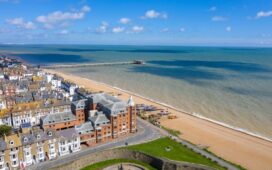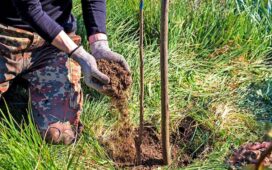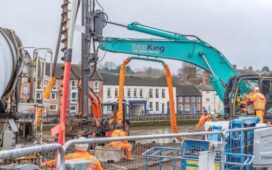
When most people plan their breaks from work, they think of sun and sea or culture-soaked city breaks, but not Iain Lathe.
The 41-year-old software test analyst from Shifnal, Shropshire, prefers something a bit ‘different’ and has become no stranger to taking time out of his nine-to-five to explore the globe’s most remote locations.
His most recent excursion? Travelling on a ‘utilitarian’ boat his mum compared to something from the film Jaws, all to see the infamous Bikini Atoll with his own eyes.
Iain, who works in a tax office, hadn’t even heard of the nuclear bomb test site in the Pacific Ocean, until he saw the trip in an extreme adventure catalogue.
‘It’s just not somewhere where people go, he tells Metro. ‘But I thought, “that sounds amazing, I want to see it with my own eyes”.’
The tiny remote ring of coral islands 2,800 miles south of Japan – and whose name would later inspire French fashion designer Louis Réard’s two-piece swimsuit – has a devastating history.

On August 6 and 9 1945, the U.S. detonated two atomic bombs over the Japanese cities of Hiroshima and Nagasaki, respectively, killing up to 246,000 people. By November the same year, U.S. military leaders began planning additional nuclear weapons tests.
Bikini Atoll in the Marshall Islands was chosen by the United States to test 23 nuclear weapons after the end of World War II, between 1946 and 1958. All 167 of the atoll’s inhabitants were told they had to leave by Navy Commodore Ben Wyatt, who said the tests were of great importance to humankind.
Among the nuclear tests was the infamous March 1, 1954 Castle Bravo bomb which was 1,000 times more powerful than the atomic bomb that decimated Nagasaki.
Today, Bikini Atoll is a World Heritage Site and still contaminated by radiation. Some signs of life are visible, including regrown plants, a recovering coral reef, and clear lagoon water, but it’s still deemed unfit for human habitation and visitors are not recommended to eat plants or wildlife.

Before going, Ian researched what the place would look like before starting the trip.
‘I Googled video footage of the bomb tests, and you can see the wave stripping the palm trees bare,’ he says. ‘I also found photos of how the islands appeared in more recent times, and they looked like a lush paradise.’
Unsurprisingly, journeys to this part of the world don’t come cheap. Iain paid £7,500 for accommodation, the boat journey and food and drink and flights were £2,500. He saves up for the trips by working up to 50-60 hours a week.
‘I’m not a massive fan of flying,’ admits Ian. ‘So the length of those flights was a particular challenge.’
Before jetting off, he had to ask his boss for three weeks off work, and break the news to his loved ones, who were understandably concerned. ‘At this point I think my boss is used to hearing about my adventures. They asked, “Is it a holiday, or one of your type of holidays?’”

‘Most people I spoke to hadn’t heard of Bikini Atoll, And then my mum always worries before I go on any of these trips. A lot of people were concerned about radiation. There is some, but it’s not to the level that it’s dangerous to be there.’
There were nine other adventure seekers on the trip with Iain and to begin their three-day exploration, they took the ‘rust bucket’ boat from Majuro to Bikini island, which is part of the atoll. It wasn’t plain sailing.
‘There was not a huge amount to do; I just sat and watched other people fish and listened to music while looking out at the sea.’ One of Iain’s new friends gave him a seasickness tablet after he forgot to pack any.
As it turns out, Iain found the stormy turbulent waters to be quite comforting when lying down. ‘Although most of the times I climbed up in the bunk it was just when the boat was moving and I’d end up hitting my head,’ he says.
Arriving on the island, Ian was pleased to see it replicated the picturesque location he’d seen in the photos. ‘ If I had to compare it in terms of the landscape, it had a similar feeling to when I went to the Exuma islands in the Bahamas [because of] the sandy beaches and crystal-clear water,’ he says.


‘It was deserted [but] it was in better condition than you might expect. It was impressively hot; I struggled a couple of times with the heat.’
While exploring Bikini’s old town, Iain found himself inside an dilapidated building. It was dark and eerie, with vines on the walls and on the ground’. But with no locals to ask about it, he was left with no clue what it had ever been used for.
Three days were spent exploring on foot Bikini and some of the other islands in the atoll. The group used kayaks to circumnavigate, with Iain admitting he’s not the best and often worried about trailing behind.
After the boat dropped off the adventurers on Bikini Atoll, the trip began with an on-foot trek on the southeast corner of Bikini Atoll where the old Enyu Airfield is. ‘We explored around the airport and the runway and then we made our way through what i’ll call a jungle up to the top end of the island.

‘Some people ran through the jungle, I just walked because there was no way I was going to be running in that heat.
‘On the first day the sea conditions were relatively calm. On the second day the water was more rough, I was trying to concentrate on what I was doing and staying on course. That knocked my confidence a little,’ he admits.
With some encouragement, he continued kayaking on day three. ‘I’m really glad they did. There were a few times when we saw sharks, about five feet, circling around us. That brought a smile to my face.’
Iain and the others slept on the boat each night and ate chicken, beef ribs, steak, and fish prepared by a chef. And There were two people in each cabin.
Looking back at his incredible trip this past summer, Iain is grateful he had a chance to learn about the history of Marshallese people, and about himself. ‘I do doubt myself, I often think, “I can’t do this” and then I go there and I do it; I’m more capable than I give myself credit for.’

Having already trekked to Mongolia, the Namib desert in Namibia, the Darién jungle in Panama and the Exuma islands in the Bahamas, and Turkmenistan in previous years, Iain’s now looking ahead to his next trip. He has ‘five or six’ adventures booked through to the end of 2026, with the next one taking place this month in Guatemala to the tallest peak in Central America, Volcán Tajumulco. ‘I’m looking forward to it, but I am wondering if I’ll be fit enough. I’m cycling up the hill near to me as many times as I can’.
One of the major benefits of going on these extreme friends is actually making friends, as well as continuing to build strong connections with fellow adventurers from around the world. It’s something he wouldn’t be able to do if he was stuck in an office. ‘That’s what keeps pulling me back — I do genuinely feel like I make friends with these people on these adventures,’ he says. ‘Or they’re people I only meet on adventures. One person was from the US, another was from Australia. They’re from all over the world!’
‘Seeing where it happened with your own eyes is definitely something I’ll remember for the rest of my life and seeing how beautiful it is there despite the catastrophic thing that happened.’
The team behind Ian’s exploration
Ian’s adventure was a test pilot for future tourism trips to the former bomb testing site by Rat Race, the UK’s largest provider of global adventure challenges. Jim Mee, the founder of Rat Race, tells Metro.co.uk it was chosen because it’s ‘one of the most remote, off-grid locations in the world’ and to give people a chance to ‘observe first-hand how natural life has miraculously recovered from nuclear destruction’.
Jim adds: ‘The Bikini Islanders who once lived there were evacuated prior to the testing and resettled on nearby Kili Island but have not yet been able to return home due to lingering radioactivity in the crops and soil.
‘It is, however, declared completely safe for tourism by the UN Nuclear Weapons Inspection teams.’
Do you have a story you’d like to share? Get in touch by emailing Claie.Wilson@metro.co.uk
Share your views in the comments below.
MORE: This is what happened when a group of children gave up their mobile phones
MORE: My husband used my disability to get away with abusing me
MORE: European city that gets ‘unjustified hate’ was just crowned best in the world














